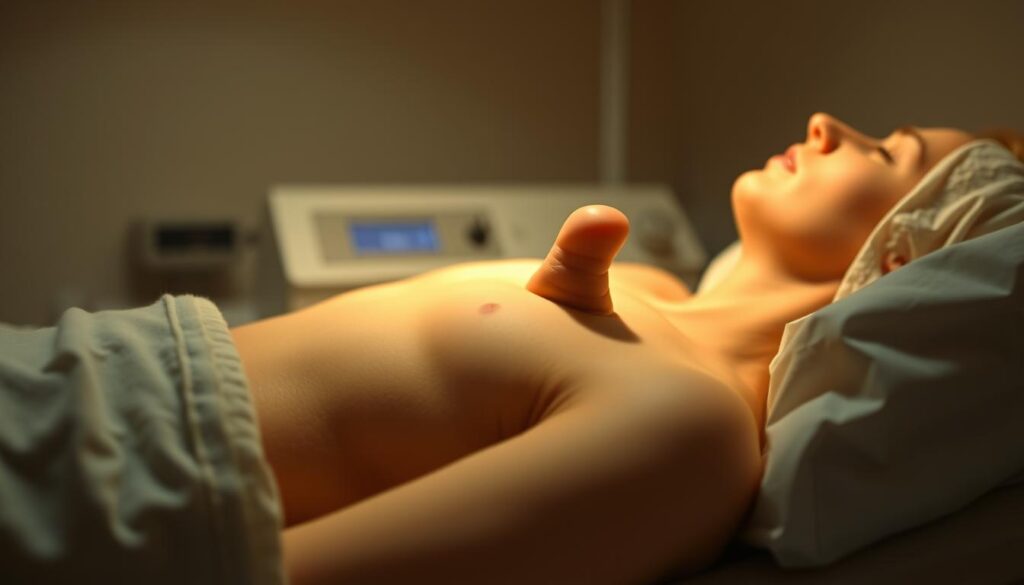Undergoing gender-affirming surgery is a significant step for many individuals. Metoidioplasty, a procedure that creates a small-sized penis from a person’s clitoris, is a complex operation that requires careful attention during the recovery phase. Understanding what to expect during each stage of recovery can help patients prepare mentally and physically for the healing process.
The journey after metoidioplasty involves several distinct phases, from immediate post-operative care to long-term healing. Proper preparation and adherence to medical guidelines are essential for achieving the best possible outcomes after this gender-affirming surgery.
Key Takeaways
- Understand the different stages of recovery to prepare mentally and physically.
- Follow medical guidelines carefully to minimize complications.
- Be aware of the distinct phases of healing after the procedure.
- Proper preparation is key to achieving optimal results.
- Adherence to post-operative care instructions is crucial.
Understanding Metoidioplasty and Initial Recovery
The metoidioplasty procedure is a gender-affirming surgery that transforms the clitoris into a functional micropenis. This complex operation is designed for individuals who have undergone testosterone therapy, resulting in clitoral enlargement.
What Metoidioplasty Entails
Metoidioplasty involves several key components, including the release of the clitoris from its supporting ligaments and the creation of a urethral extension to enable standing urination. The procedure may also include forming a scrotum from the labia majora, utilizing tissue grafts where necessary. By leveraging the enlarged clitoris, metoidioplasty achieves a natural appearance and preserves erogenous sensation, resulting in a penis typically ranging from 3 to 6 cm in size.
The First 48 Hours After Surgery
The initial 48 hours post-metoidioplasty are critical for monitoring surgery outcomes and managing potential complications. Patients are closely observed for signs of pain, bleeding, and proper urinary catheter function. Significant swelling and discomfort are common during this period, and the presence of drains and catheters requires careful management. Hospitalization ensures that vital signs, pain levels, and the surgical site are closely monitored to facilitate proper healing.
Hospital Recovery Phase

The initial recovery phase after metoidioplasty involves close monitoring in a hospital setting. During this period, medical professionals closely monitor the patient’s healing progress and manage post-surgical care.
Managing Pain and Discomfort
Pain management is a critical component of hospital recovery. Medical staff administer appropriate medications to keep discomfort at manageable levels, ensuring patients can recover comfortably.
Catheter and Drain Care
The urinary catheter remains in place throughout the hospital stay and for about 21 days total to allow the urethra to heal. Two drains are placed in the perineal area to remove excess fluid and blood, typically removed within 24-48 hours.
Preparing for Discharge
Before discharge, the surgeon and nursing staff provide detailed instructions on home care, medication schedules, and warning signs that require immediate medical attention, preparing patients for a smooth transition home.
Essential Home Care Instructions
The recovery journey continues at home with a set of essential care instructions that are crucial for healing and minimizing the risk of infection. Proper care at this stage is vital to ensure a smooth and complication-free recovery.
Incision Care and Hygiene
Keeping the surgical area clean and dry is paramount. Gently wash the area daily with warm, soapy water, and pat it dry. It’s crucial to avoid using hydrogen peroxide or alcohol, as they can impede the healing process.
Proper incision care is key to preventing infection. Avoid applying any creams, ointments, or lotions to the surgical area unless specifically prescribed by your surgeon.
Medication Management
Adhering to the prescribed medication regimen is critical. Take pain management medications and antibiotics exactly as directed by your surgeon. Completing the full course of antibiotics is essential, even if you start feeling better before finishing them.
Dietary Considerations
A well-balanced diet plays a significant role in the recovery process. Focus on consuming protein-rich foods to support tissue repair, and include plenty of fiber to prevent constipation. Staying hydrated is also crucial; drink ample water to aid in the healing processes.
Initially, a residue-free diet may be recommended to minimize strain on the surgical area. Managing pain and discomfort is also linked to dietary choices and overall care during the recovery period.
Metoidioplasty After Recovery: What to Expect

Metoidioplasty after recovery is a significant milestone for individuals undergoing this surgery. The process involves a series of physical changes and healing milestones that patients should be aware of to manage their expectations effectively.
Timeline for Healing Milestones
The healing timeline after metoidioplasty follows a predictable pattern. Most visible bruising resolves within 2-3 weeks, while significant swelling subsides within 6-8 weeks. Full recovery typically takes 6-8 weeks, though some aspects of healing continue for several months.
| Healing Milestone | Timeline |
|---|---|
| Bruising Resolution | 2-3 weeks |
| Swelling Subsidence | 6-8 weeks |
| Full Recovery | 6-8 weeks |
Physical Changes and Sensations
During the recovery period, patients may experience various physical changes and sensations. The result of metoidioplasty is a functional micropenis of about 3-6 centimeters in length, allowing for urination while standing and providing erogenous stimulation. For more detailed metoidioplasty aftercare guidelines, patients can refer to the provided resource.
Sensation changes are common, with numbness or hypersensitivity gradually transitioning to more normal sensation as nerve healing progresses over 3-6 months. The final aesthetic appearance continues to improve over 6-12 months as residual swelling resolves and tissues fully settle.
Activity Restrictions and Gradual Return to Normal
Recovering from metoidioplasty involves a delicate balance between rest and movement to support the healing process. It’s essential to understand the activity restrictions and guidelines for a gradual return to normal activities to ensure a smooth and complication-free recovery.
Rest and Movement Guidelines
During the initial 6-8 weeks after surgery, it’s crucial to avoid strenuous activities, heavy lifting (over 10 pounds), and prolonged physical exertion. However, complete bed rest is not recommended; instead, patients should maintain light activity such as short, frequent walks to promote circulation and prevent blood clots.
Sitting and Positioning Techniques
Sitting may be uncomfortable and potentially harmful to the surgical site. Patients should follow their surgeon’s specific guidelines regarding sitting duration and positioning. Often, using a donut cushion or limiting sitting to short periods can help minimize discomfort and support healing.
Returning to Work and Daily Activities
The timeline for returning to work depends on the physical demands of the job. Office workers may return in 4-6 weeks, while those with physically demanding jobs may need 8-12 weeks. It’s also important to avoid driving while taking prescription pain medications.
| Activity | Recommended Timeframe | Guidelines |
|---|---|---|
| Strenuous Activities | 6-8 weeks post-surgery | Avoid heavy lifting and prolonged exertion |
| Light Walking | Immediately post-surgery | Short, frequent walks to promote circulation |
| Returning to Work | 4-12 weeks post-surgery | Depends on job’s physical demands |
| Driving | After stopping pain medications | Avoid driving while on prescription pain meds |
Recognizing and Managing Complications
Understanding the potential complications that can occur after metoidioplasty is key to navigating the recovery process successfully. While the surgery is generally safe, being aware of the possible issues can help in managing them effectively.
Warning Signs to Watch For
Vigilant monitoring for potential complications is essential during recovery. Key warning signs include fever above 100.4°F (38°C), increasing rather than decreasing pain, unusual drainage or odor from the surgical site, and difficulty urinating. These symptoms can indicate infection or other issues that require immediate attention.
- Fever over 100.4°F (38°C)
- Increasing pain
- Unusual drainage or odor
- Difficulty urinating
When to Contact Your Healthcare Provider
If you experience any of the warning signs, it’s crucial to contact your healthcare provider immediately. Bleeding beyond light spotting, especially if it’s bright red or increasing in volume, requires immediate medical attention as it may indicate a surgical site complication. Prompt communication with your healthcare team about any concerning symptoms is vital for optimal outcomes.
Common Complications and Solutions
Urethral complications are among the most common issues after metoidioplasty, including strictures (narrowing) that may cause difficulty urinating and fistulas (abnormal connections) that can lead to urine leakage through the incision. For more information on preventive measures and managing health after surgery, you can visit this resource on general health and preventive measures.
Conclusion: Long-Term Recovery and Results
The long-term results of metoidioplasty can be truly transformative, offering patients a functional micropenis and improved overall well-being. After surgery, patients can expect a micropenis typically 3-6 cm in length with an aesthetic appearance similar to a natural penis, retaining erogenous sensation.
The recovery process is extensive, with complete healing and final results taking up to a year to manifest. Regular follow-up appointments with the surgical team are crucial during this period to monitor healing and address any concerns.
Some patients may choose to undergo additional procedures, such as testicular implant placement, to further enhance their gender expression. While metoidioplasty creates a smaller penis compared to other reconstructive options, many patients appreciate the preserved natural sensation and simpler recovery.
Ultimately, successful long-term outcomes depend on a combination of skilled surgical technique, diligent post-operative care, and patience throughout the healing process.


